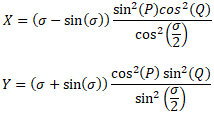The Ultimate Distance Calculator Guide: Planning Your Perfect Road Trip(2023)
A distance calculator is a powerful tool that allows you to measure the distance between two or more locations on the Earth’s surface. It leverages mathematical formulas and geographic coordinates to provide accurate measurements. By inputting the starting point and destination, you can quickly obtain the distance in miles, kilometers, or other units.
Understanding the Importance of Distance Calculation
While spontaneity is a thrill, having a well-thought-out plan ensures a more enjoyable journey. Distance calculation is at the core of this planning process. Knowing the distance between your starting point and destination helps estimate travel time and fuel costs and allows for a more informed decision-making process.
The Significance of Accurate Distance Calculation
Accurate distance calculation is essential for various reasons. When planning a road trip, knowing the distance between stops helps estimate travel time and fuel costs. For air travel, distance calculation influences flight durations and ticket prices. Additionally, it aids in finding nearby attractions, hotels, and restaurants.
Distance Calculation Methods
There are several distance calculation methods, each suited for different scenarios. Two widely used formulas are the Haversine Formula and the Vincenty Formula. The Haversine Formula calculates distances on a sphere’s surface, while the Vincenty Formula takes into account the Earth’s ellipsoidal shape, making it more precise for long distances.
Haversine Formula for Great Circle Distance
The Haversine Formula is ideal for short distances, such as driving between cities. It simplifies calculations by assuming the Earth is a perfect sphere, disregarding its oblate nature.
Vincenty Formula for Ellipsoidal Distance
For greater accuracy over long distances, the Vincenty Formula is preferred. It considers the equatorial and polar radii, resulting in more precise measurements across the globe.
Types of Distance Calculators: From Basic to Advanced
Distance calculators come in various forms, catering to different levels of planning needs. Basic point-to-point calculators are perfect for simple journeys, while multi-stop route planners are essential for more complex itineraries. For those seeking real-time updates and integration with traffic and weather information, advanced tools offer invaluable insights.
Basic Point-to-Point Calculators
Basic point-to-point calculators are user-friendly and ideal for calculating distances between two locations. Simply enter your starting point and destination, and the calculator provides an estimate of the total distance in miles or kilometers.
Multi-Stop Route Planners
For travelers with multiple stops or detours, multi-stop route planners come to the rescue. These calculators allow you to add waypoints along your route, ensuring you can plan and visualize the entire journey with ease.
Real-Time Traffic and Weather Integrated Tools
For enhanced planning and flexibility, consider using distance calculators that integrate real-time traffic and weather information. These tools help you anticipate potential delays and make on-the-go adjustments to your route.
How to Use an Ultimate Distance Calculator Guide: Step-by-Step
Using a distance calculator is straightforward, and following a step-by-step guide will ensure you make the most of this powerful tool.
Inputting Your Starting Point and Destination
Begin by entering the starting point of your road trip and the destination you wish to reach. This information serves as the foundation for the distance calculation.
Customizing Stops and Detours
If your road trip involves multiple stops or detours along the way, add these waypoints to the route planner. This feature allows you to plan your journey with precision, taking into account all your planned destinations.
Analyzing Estimated Travel Time and Fuel Costs
Once you have entered your route details, the distance calculator will generate the estimated travel time and approximate fuel costs. This information is invaluable for budgeting and managing your time effectively.
Utilizing Distance Calculators in Everyday Life
Distance calculators play a significant role in everyday life, simplifying travel and navigation. Here are some common scenarios where distance calculators are helpful:
Planning Road Trips
Before hitting the road, a distance calculator helps you determine the most efficient route, minimizing travel time and expenses.
Booking Flights
When booking flights, knowing the distance between departure and arrival airports assists in making informed choices and comparing ticket prices.
Finding Nearby Attractions
Travelers can discover exciting attractions near their location using a distance calculator, enhancing their overall experience.
The Art of Efficient Route Planning: Tips and Tricks
Efficient route planning is an art that balances time efficiency with exploring scenic routes and points of interest.
Balancing Scenic Routes with Time Efficiency
While covering long distances efficiently is essential, don’t be afraid to embrace scenic routes and detours that add beauty and charm to your journey.
Identifying Rest Areas and Points of Interest
To avoid fatigue during your road trip, plan rest stops at regular intervals. Additionally, research points of interest along the way to make the most of your journey.
Navigating Challenges: Dealing with Unforeseen Circumstances
Despite thorough planning, road trips may present unforeseen challenges. Stay prepared and be flexible to adapt to changing circumstances.
Road Closures and Diversions
Stay updated on road closures and diversions, especially during adverse weather conditions or maintenance work.
Real-Time Traffic Updates
Make use of real-time traffic updates provided by distance calculator apps to avoid congested routes and find alternative paths.
Popular Distance Calculation Tools and Apps
The digital age has brought us numerous distance calculation tools and apps that are user-friendly and readily accessible. Some of the most popular ones include:
Google Maps
Google Maps is an all-in-one navigation tool, that provides distance calculation, real-time traffic updates, and directions.
MapQuest
MapQuest offers a comprehensive distance calculator, maps, and turn-by-turn directions to make travel planning a breeze.
DistanceFromTo.net
DistanceFromTo.net is a straightforward distance calculator that quickly computes distances between two points.
Understanding Perplexity and Burstiness in Distance Calculation Algorithms
Perplexity and burstiness are crucial factors in distance calculation algorithms. Perplexity refers to the uncertainty in a location’s position, affecting GPS accuracy. Burstiness refers to clustered location data, which impacts the distribution of distances in certain areas.
How Distance Calculation Influences Route Planning
Distance calculation significantly influences route planning, as it directly affects travel time and costs. Optimal routes ensure smoother journeys and reduced fuel consumption.
Importance of Context in Distance Measurement
Considering contextual information, such as road conditions and terrain, alongside distance calculation results in more precise and realistic travel plans.
Benefits of Utilizing a Reliable Distance Calculator
Using a reliable distance calculator enhances travel planning efficiency, saves time, and minimizes unexpected travel-related expenses.
The Evolution of Distance Calculation Technology
The history of distance calculation is a testament to human ingenuity. From ancient methods based on landmarks to modern satellite-based technologies, the evolution has been remarkable.
Early Methods
In ancient times, travelers used natural landmarks, such as mountains and rivers, to estimate distances between places.
Modern Innovations
Advancements in technology led to the development of GPS and sophisticated algorithms, revolutionizing distance calculation.
The Human Element in Distance Calculation
Despite technological advancements, the human element is still crucial in verifying and interpreting distance calculation results.
Using Distance Calculation APIs for Web Development
Web developers integrate distance calculation APIs into various applications to provide users with accurate location-based information.
Keeping Up with Real-Time Traffic Information
Combining distance calculation with real-time traffic updates helps travelers navigate congestion and find faster routes.
Environmental Impact of Traveling and Distance Optimization
Optimizing distances can have a positive environmental impact, reducing greenhouse gas emissions from transportation.
Distance in a coordinate system
Distance in a 2D coordinate plane:
The distance between two points on a 2D coordinate plane can be found using the following distance formula
d = √(x2 – x1)2 + (y2 – y1)2
where (x1, y1) and (x2, y2) are the coordinates of the two points involved. The order of the points does not matter for the formula as long as the points chosen are consistent. For example, given the two points (1, 5) and (3, 2), either 3 or 1 could be designated as x1 or x2 as long as the corresponding y-values are used:
Using (1, 5) as (x1, y1) and (3, 2) as (x2, y2):
| d = | √(3 – 1)2 + (2 – 5)2 |
| = | √22 + (-3)2 |
| = | √4 + 9 |
| = | √13 |
Using (3, 2) as (x1, y1) and (1, 5) as (x2, y2):
| d = | √(1 – 3)2 + (5 – 2)2 |
| = | √(-2)2 + 32 |
| = | √4 + 9 |
| = | √13 |
In either case, the result is the same.
Distance in a 3D coordinate space:
The distance between two points on a 3D coordinate plane can be found using the following distance formula
d = √(x2 – x1)2 + (y2 – y1)2 + (z2 – z1)2
where (x1, y1, z1) and (x2, y2, z2) are the 3D coordinates of the two points involved. Like the 2D version of the formula, it does not matter which of two points is designated (x1, y1, z1) or (x2, y2, z2), as long as the corresponding points are used in the formula. Given the two points (1, 3, 7) and (2, 4, 8), the distance between the points can be found as follows:
| d = | √(2 – 1)2 + (4 – 3)2 + (8 – 7)2 |
| = | √12 + 12 + 12 |
| = | √3 |
Distance between two points on Earth’s surface
There are a number of ways to find the distance between two points along the Earth’s surface. The following are two common formulas.
Haversine formula:
The haversine formula can be used to find the distance between two points on a sphere given their latitude and longitude:

In the haversine formula, d is the distance between two points along a great circle, r is the radius of the sphere, ϕ1 and ϕ2 are the latitudes of the two points, and λ1 and λ2 are the longitudes of the two points, all in radians.
The haversine formula works by finding the great-circle distance between points of latitude and longitude on a sphere, which can be used to approximate distance on the Earth (since it is mostly spherical). A great circle (also orthodrome) of a sphere is the largest circle that can be drawn on any given sphere. It is formed by the intersection of a plane and the sphere through the center point of the sphere. The great-circle distance is the shortest distance between two points along the surface of a sphere.
Results using the haversine formula may have an error of up to 0.5% because the Earth is not a perfect sphere, but an ellipsoid with a radius of 6,378 km (3,963 mi) at the equator and a radius of 6,357 km (3,950 mi) at a pole. Because of this, Lambert’s formula (an ellipsoidal-surface formula), more precisely approximates the surface of the Earth than the haversine formula (a spherical-surface formula) can.
Lambert’s formula:
Lambert’s formula (the formula used by the calculators above) is the method used to calculate the shortest distance along the surface of an ellipsoid. When used to approximate the Earth and calculate the distance on the Earth’s surface, it has an accuracy on the order of 10 meters over thousands of kilometers, which is more precise than the haversine formula.
Lambert’s formula is as follows:

where a is the equatorial radius of the ellipsoid (in this case the Earth), σ is the central angle in radians between the points of latitude and longitude (found using a method such as the haversine formula), f is the flattening of the Earth, and X and Y are expanded below.

Where P = (β1 + β2)/2 and Q = (β2 – β1)/2
In the expressions above, β1 and β1 are reduced latitudes using the equation below:
tan(β) = (1 – f)tan(ϕ)
where ϕ is the latitude of a point.
Note that neither the haversine formula nor Lambert’s formula provides an exact distance because it is not possible to account for every irregularity on the surface of the Earth.
FAQs
What is a distance calculator?
A distance calculator is a tool that measures the distance between two or more locations on the Earth’s surface.
How does distance calculation affect route planning?
Distance calculation directly impacts travel time and costs, influencing the selection of optimal routes.
Which formula is best for distance calculation?
The Haversine Formula is suitable for short distances, while the Vincenty Formula is more precise over long distances.
Are distance calculators available as apps?
There are various distance calculation apps like Google Maps, MapQuest, and DistanceFromTo.net.
How can distance optimization benefit the environment?
Optimizing distances can reduce greenhouse gas emissions, positively impacting the environment.






